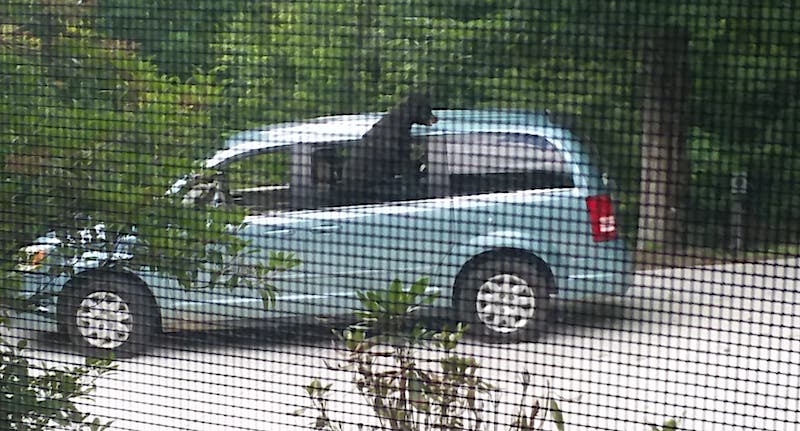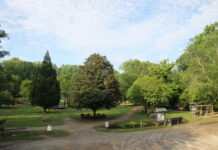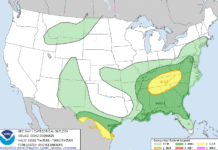It wasn’t the Easter bunny but rather a bear cub that recently turned up at a Northeast Georgia home. Video of the cub eating on the family’s front porch near Raper Mountain captured the imaginations and hearts of wildlife lovers.
Ann Sutton shot the video from inside her house, mere feet from where the cub hungrily devoured his meal, ignoring her even as she tapped on the window. Sutton called the small cub’s appearance “an Easter weekend surprise!”
“This little guy ate all of the cats’ meal, and I did not have the heart to send him away,” Sutton wrote on her Facebook page.
“Cute,” “cuddly,” and “precious” are just a few of the words commenters used to describe the scraggly-looking cub.
The Sutton’s home in northern Habersham County sits in a wooded area. And while bear sightings are not uncommon, this one was different.
“We have visits by full-grown bears. Never one this small,” Sutton tells Now Habersham.
Cubs grow up
As compelling as cubs are to watch, State Bear Biologist Adam Hammond says people should resist the tendency to see them as anything other than wild animals.

“Bears are cute and cuddly when they’re small, but when a bear is 500 pounds and is used to getting fed, people’s home deadbolts and doors don’t keep them out.”
Hammond says the Suttons did the right thing by contacting the Georgia Department of Natural Resources. The family is now working with DNR to capture and relocate the cub.
Judging from its size – an estimated 10 to 15 pounds – Hammond suspects the cub was separated from its mother last fall.
“The cub that you’re seeing is probably last year’s cub that more than likely was orphaned at a younger age. That’s my guess. Most bear cubs in their second year should be at least 50 pounds,” he explains.
Being significantly underweight, it’s likely the bear didn’t have enough time to learn good foraging habits from its mother before she was killed. A poor acorn crop last fall may have contributed to its stunted growth.
Hungry and left to fend for itself, Hammond says the fact this cub is still alive means it has a chance to survive and make it on its own.
Native omnivores
Black bears are native to North Georgia: The region has approximately 3,000 of them. While they’re omnivorous, 80-90 percent of their diet is plant-based. They forage for nuts (hard mast) and berries (soft mast). When mast crops fail, bears search for alternate food sources.

“Bears like human-provided food because they like sources that are easy, and they often follow their nose,” Hammond says. He describes black bears as “resourceful” and “opportunistic.”
Such descriptions bring to mind the beloved fictional bear characters Yogi Bear and Winnie the Pooh.
And there’s the rub.
Humans have become so enamored with cute, funny, embraceable depictions of bears (still have that old teddy bear from childhood?) it’s easy to forget wildlife experts’ advice.
Secure those bird feeders, squirrel feeders, pet and livestock food bags. Clean up those greasy barbecues, smokers, and fish cookers. Minimize the attractants and availability of food in your yard to keep bears in the wild where they belong.
If a black bear does venture onto your property and refuses to leave, do as the Sutton’s did and get experts involved. Hammond suggests reaching out to the DNR Wildlife Division offices in Gainesville or Rome (where he’s based).
RELATED
- As spring emerges, so do hungry bears
- Gainesville PD warns ‘don’t feed the bear’
- DNR responds to homeowner’s concerns about bear in neighborhood
- Bear breaks into Clayton hardware store
A better life
Since their ‘Easter surprise’ arrived, the Suttons have rearranged their cat feeding schedule.
“I feed them early, 6ish, and only leave the bowl out for 30 minutes,” Ann says. “The bear apparently prefers not to get up that early.”
Sleep-loving is another trait famed animators William Hanna and Joseph Barbera and English author A.A. Milne attached to their beloved characters. But don’t let those lazy bear images fool you.

Last year a black bear spotted milling around Gainesville and Alpharetta traveled over 1,000 miles through four states to get back to her home in Tennessee. She was relocated to the Cherokee National Forest from the Great Smoky Mountains Park after exhibiting food-conditioning behavior. She looted campsites and backpacks and was deemed a nuisance bear; behaviors that developed because she grew accustomed to eating people’s food and garbage.
“It’s not normal for them to cause harm to people, but they are capable,” Hammond cautions. “They’re beautiful wild animals, but we have to keep them in that wild category as best we can, based on their behavior and our behavior.”
In his 23 years of researching and managing bear populations in Georgia, Hammond says he’s only seen a cub this small at this age a few times. Once they trap it and check it for any possible health problems, DNR will mark the cub so it can be uniquely identified. They’ll then set it loose in the wild, away from people and human food sources, so that, hopefully, in a few months, it can recalibrate its cycle.
“He made it through probably the hardest time, which was the winter,” says Hammond. “If he can get through these next six months without becoming dependent on people, we think it will have a pretty good shot.”







